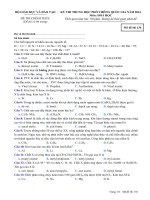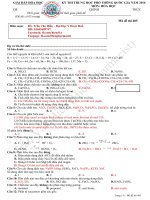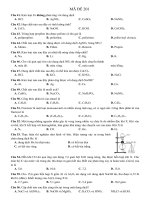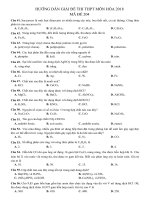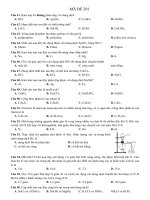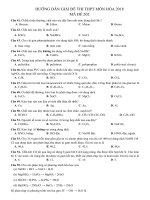- Trang chủ >>
- Đề thi >>
- Tuyển sinh lớp 10
Đề thi Cambridge IGCSE™ chính thức môn Hoá tháng 062023 (Đề trắc nghiệm_Số 12_ Cơ bản_Có đáp án)
Bạn đang xem bản rút gọn của tài liệu. Xem và tải ngay bản đầy đủ của tài liệu tại đây (427.96 KB, 19 trang )
Cambridge IGCSE™
CHEMISTRY
0620/12
Paper 1 Multiple Choice (Core)
May/June 2023
45 minutes
You must answer on the multiple choice answer sheet.
*2250009019*
You will need: Multiple choice answer sheet
Soft clean eraser
Soft pencil (type B or HB is recommended)
INSTRUCTIONS
There are forty questions on this paper. Answer all questions.
For each question there are four possible answers A, B, C and D. Choose the one you consider correct
and record your choice in soft pencil on the multiple choice answer sheet.
Follow the instructions on the multiple choice answer sheet.
Write in soft pencil.
Write your name, centre number and candidate number on the multiple choice answer sheet in the
spaces provided unless this has been done for you.
Do not use correction fluid.
Do not write on any bar codes.
You may use a calculator.
INFORMATION
The total mark for this paper is 40.
Each correct answer will score one mark.
Any rough working should be done on this question paper.
The Periodic Table is printed in the question paper.
This document has 16 pages. Any blank pages are indicated.
IB23 06_0620_12/6RP
© UCLES 2023
[Turn over
2
1
Four physical changes of ethanol are listed.
1
condensation
2
evaporation
3
freezing
4
boiling
In which changes do the particles move further apart?
A
2
3
1 and 2
B
1 and 3
C
2 and 4
D
3 and 4
Which statement explains why water is a compound?
A
The hydrogen and oxygen atoms in a molecule of water can only be separated by chemical
means.
B
The hydrogen and oxygen atoms in a molecule of water can be separated using physical
means.
C
The number of hydrogen and oxygen atoms in a molecule of water is variable.
D
Water has the same chemical properties as both hydrogen and oxygen.
An atom of element X contains:
●
5 protons
●
6 neutrons
●
5 electrons.
Which statements about element X are correct?
A
1
X has an atomic number of 6.
2
X has a nucleon number of 11.
3
X is in Group II of the Periodic Table.
4
X is in the second period of the Periodic Table.
1 and 3
© UCLES 2023
B
1 and 4
C
2 and 3
0620/12/M/J/23
D
2 and 4
3
4
5
Which row describes properties of lithium fluoride?
electrical conductivity
when solid
electrical conductivity
when molten
melting point
A
does not conduct
conducts
high
B
does not conduct
does not conduct
low
C
conducts
conducts
high
D
conducts
does not conduct
low
Ammonia, NH3, is a covalent molecule.
Which diagram shows the outer-shell electron arrangement in a molecule of ammonia?
A
H
H
N
B
H
H
H
H
C
D
N
H
H
H
6
N
N
H
H
H
Which substance has a giant covalent structure?
A
ethanol
B
graphite
C
methane
D
sodium chloride
© UCLES 2023
0620/12/M/J/23
[Turn over
4
7
Sodium burns in oxygen to form sodium oxide.
What is the balanced equation for the reaction?
8
A
4Na + 2O 2Na2O
B
4Na + O2 2Na2O
C
2Na2 + O2 2Na2O
D
2Na2 + 2O 2Na2O
What is the relative formula mass of Mg(OH)2?
A
9
21
B
30
C
42
D
58
Dilute sulfuric acid is electrolysed using inert electrodes. The apparatus is set up as shown.
dilute
sulfuric acid
graphite
cathode
graphite
anode
–
+
30 cm3 of a gas is collected at the cathode. A different gas is collected at the anode.
Which row is correct?
gas at
cathode
gas at
anode
volume of gas
collected at anode
/ cm3
A
hydrogen
oxygen
15
B
hydrogen
oxygen
30
C
oxygen
hydrogen
15
D
oxygen
hydrogen
30
© UCLES 2023
0620/12/M/J/23
5
10 Four statements about hydrogen fuel cells are listed.
1
The fuel cell converts chemical energy into electrical energy.
2
In the fuel cell, hydrogen combines with oxygen.
3
Carbon dioxide and water are produced in the fuel cell.
4
The hydrogen fuel is extracted from the air.
Which statements are correct?
A
1 and 2
B
1 and 4
C
2 and 3
D
2 and 4
11 5 g of four different fuels are set alight and placed under a beaker containing 50 cm3 of water.
The temperature of the water is taken at the start and after five minutes.
Which fuel releases the most energy?
temperature
at start
/ C
temperature
after five minutes
/ C
A
15
23
B
21
31
C
28
47
D
30
48
12 Which changes increase the rate of reaction?
A
1
increasing the concentration of the reactants
2
increasing the particle size of a solid reactant
3
increasing the temperature
1, 2 and 3
B
1 and 2 only
C
1 and 3 only
D
2 and 3 only
13 Which reaction is reversible?
A
an iron nail rusting when left in moist air
B
limestone reacting with an acid to form carbon dioxide gas
C
magnesium burning in air to produce a white ash
D
white anhydrous copper(II) sulfate turning blue when water is added
© UCLES 2023
0620/12/M/J/23
[Turn over
6
14 The equation for the reaction between iron(III) oxide and carbon is shown.
2Fe2O3 + 3C 4Fe + 3CO2
Which type of reaction does iron(III) oxide undergo?
A
reduction
B
precipitation
C
oxidation
D
combustion
15 Copper(II) chloride is made when copper(II) carbonate reacts with dilute hydrochloric acid.
What are the other products in this reaction?
A
water and carbon dioxide
B
carbon dioxide only
C
water and hydrogen
D
hydrogen only
16 Rubidium is in Group I and strontium is in Group II of the Periodic Table.
Which row describes the nature of rubidium oxide, Rb2O, and strontium oxide, SrO?
Rb2O
SrO
A
acidic
acidic
B
acidic
basic
C
basic
acidic
D
basic
basic
17 Magnesium sulfate is a soluble solid which is formed when insoluble magnesium oxide reacts
with dilute sulfuric acid.
Which method is used to prepare solid magnesium sulfate?
A
Excess sulfuric acid is reacted with magnesium oxide. The mixture is evaporated to dryness.
B
Excess sulfuric acid is reacted with magnesium oxide. The precipitate is filtered, washed and
dried.
C
Sulfuric acid is reacted with excess magnesium oxide. The mixture is filtered and the filtrate
is evaporated to dryness.
D
Sulfuric acid is reacted with excess magnesium oxide. The precipitate is filtered, washed and
dried.
© UCLES 2023
0620/12/M/J/23
7
18 Q and R are elements in the same period of the Periodic Table.
Q has 7 electrons in its outer shell and R has 2 electrons in its outer shell.
Which statement about Q and R is correct?
A
Q is a metal and R is a non-metal.
B
Q and R have different numbers of electron shells.
C
R is found to the right of Q in the Periodic Table.
D
The proton number of R is less than the proton number of Q.
19 Which statement about alkali metals is correct?
A
Lithium is more dense than sodium.
B
Sodium is more reactive than potassium.
C
Sodium has a higher melting point than potassium.
D
They are in Group II of the Periodic Table.
20 Aqueous bromine is added to aqueous sodium iodide.
bromine + sodium iodide ......1...... + ......2......
What are the products of this reaction?
1
2
A
iodide
sodium bromide
B
iodide
sodium bromine
C
iodine
sodium bromide
D
iodine
sodium bromine
21 Which row describes the properties of a transition element?
melting
point
density
forms coloured
compounds
A
high
low
no
B
high
high
yes
C
low
low
no
D
low
low
yes
© UCLES 2023
0620/12/M/J/23
[Turn over
8
22 Which row describes the properties of argon?
property 1
property 2
A
inert
diatomic
B
inert
monatomic
C
reactive
diatomic
D
reactive
monatomic
23 Which row identifies the properties of zinc?
thermal
conductivity
reacts with
dilute acid
A
good
yes
B
good
no
C
poor
yes
D
poor
no
24 Uses of metals depend on their properties.
Which property is necessary for the use given?
use of the metal
property of the metal
A
car bodies
ductile
B
cutlery
conducts heat
C
food containers
resists corrosion
D
overhead electrical cables
high density
25 Which compounds both contribute to acid rain?
A
carbon monoxide and carbon dioxide
B
carbon monoxide and oxides of nitrogen
C
oxides of nitrogen and sulfur dioxide
D
sulfur dioxide and carbon dioxide
© UCLES 2023
0620/12/M/J/23
9
26 P, Q, R and S are metals.
P reacts with dilute hydrochloric acid, forming hydrogen.
Q reacts violently with water.
R reacts with water to give hydrogen.
S is formed by heating its oxide with carbon.
Which row identifies the metals?
P
Q
R
S
A
copper
sodium
potassium
iron
B
zinc
magnesium
calcium
iron
C
zinc
sodium
calcium
magnesium
D
iron
potassium
sodium
zinc
27 Which compound is formed when iron rusts?
A
anhydrous iron(II) oxide
B
anhydrous iron(III) oxide
C
hydrated iron(III) hydroxide
D
hydrated iron(III) oxide
28 Which reaction in the blast furnace releases heat energy?
A
C + O2 CO2
B
CaCO3 CaO + CO2
C
CO2 + C 2CO
D
Fe2O3 + 3CO 2Fe + 3CO2
© UCLES 2023
0620/12/M/J/23
[Turn over
10
29 A wax candle is made from a mixture of hydrocarbons.
The candle is lit and placed in a gas jar along with a strip of cobalt(II) chloride test paper as
shown.
cobalt(II) chloride paper
gas jar
combustion products
wax candle
After a short time, the oxygen in the jar is used up and the candle flame goes out.
Which substance does the cobalt(II) chloride paper identify?
A
carbon dioxide
B
carbon monoxide
C
sulfur dioxide
D
water
30 Urea, CO(NH2)2, is used as a fertiliser.
Which element that plants need for improved plant growth is provided by urea?
A
carbon
B
hydrogen
C
nitrogen
D
oxygen
© UCLES 2023
0620/12/M/J/23
11
31 The percentage composition of gases on Neptune is shown.
percentage
composition / %
gas
hydrogen
80
helium
18
methane
1.5
other gases
0.5
Which statement about the atmospheres on Neptune and on the Earth is correct?
A
There is more helium on Neptune than oxygen on the Earth.
B
There is less methane on Neptune than carbon dioxide on the Earth.
C
There is less hydrogen on the Earth than on Neptune.
D
There is more helium on the Earth than on Neptune.
32 Which row shows the general formula for alkenes and for alcohols?
alkenes
alcohols
A
CnH2n
CnH2n+1COOH
B
CnH2n
CnH2n+1OH
C
CnH2n+2
CnH2n+1COOH
D
CnH2n+2
CnH2n+1OH
33 A molecule has the formula C2H5Cl.
What is its chemical name?
A
chloroethane
B
chloroethanol
C
chloroethene
D
chloromethanol
34 Which compound rapidly decolourises aqueous bromine?
A
ethane
B
ethanoic acid
C
ethanol
D
ethene
© UCLES 2023
0620/12/M/J/23
[Turn over
12
35 Compound Z has the molecular formula C2H6O.
Which statement about compound Z is correct?
A
Z is unsaturated.
B
Z is a carboxylic acid.
C
Z is formed by the reaction of ethane with steam.
D
Z is used as a fuel.
36 What is the formula of the salt formed when aqueous ethanoic acid reacts with
calcium carbonate?
A
Ca(CH3COOH)2
B
Ca(CH3COO)2
C
Ca2CH3COOH
D
Ca2CH3COO
37 Rock salt is a mixture of salt and sand.
The method used to separate the sand from the salt is listed.
step 1
Crush the rock salt, add to warm water and stir.
step 2
Pour the mixture through a filter paper held in a funnel.
step 3
Evaporate the water to crystallise the salt.
Which statement about the method is correct?
A
The filtrate in step 2 is pure water.
B
The residue in step 2 is pure crystals of salt.
C
The solute is salt.
D
The solvent is a mixture of salt and water.
© UCLES 2023
0620/12/M/J/23
13
38 Chromatography is carried out on mixture Y and dyes E, F, G and H. The chromatogram is
shown.
solvent front
baseline
Y
E
F
G
H
Which dyes are present in mixture Y?
A
E and G
B
E and H
C
F and G
D
F and H
39 A fractionating column is used to separate the hydrocarbon fractions in petroleum by fractional
distillation.
Which row describes the properties of the fractions that condense at the top of the fractionating
column?
size of molecule
boiling point
A
large
high
B
large
low
C
small
high
D
small
low
40 When acid is added to salt X, a gas is produced which turns limewater milky.
When sodium hydroxide is added to salt X, a gas is produced which turns litmus paper blue.
What is X?
A
CaCO3
© UCLES 2023
B
(NH4)2CO3
C
NH4NO3
0620/12/M/J/23
D
ZnCO3
14
BLANK PAGE
© UCLES 2023
0620/12/M/J/23
15
BLANK PAGE
Permission to reproduce items where third-party owned material protected by copyright is included has been sought and cleared where possible. Every
reasonable effort has been made by the publisher (UCLES) to trace copyright holders, but if any items requiring clearance have unwittingly been included, the
publisher will be pleased to make amends at the earliest possible opportunity.
To avoid the issue of disclosure of answer-related information to candidates, all copyright acknowledgements are reproduced online in the Cambridge
Assessment International Education Copyright Acknowledgements Booklet. This is produced for each series of examinations and is freely available to download
at www.cambridgeinternational.org after the live examination series.
Cambridge Assessment International Education is part of Cambridge Assessment. Cambridge Assessment is the brand name of the University of Cambridge
Local Examinations Syndicate (UCLES), which is a department of the University of Cambridge.
© UCLES 2023
0620/12/M/J/23
© UCLES 2023
21
45
39
Y
12
Mg
magnesium
24
20
Ca
calcium
40
38
11
Na
sodium
23
19
K
potassium
39
37
22
73
Ta
72
Hf
89
57–71
lanthanoids
88
56
0620/12/M/J/23
Rf
Db
Th
thorium
232
–
90
89
Ac
140
139
actinium
Ce
cerium
La
231
protactinium
Pa
91
141
praseodymium
Pr
59
58
57
lanthanum
–
dubnium
–
rutherfordium
105
181
tantalum
93
238
uranium
U
92
144
neodymium
Nd
60
–
seaborgium
Sg
106
184
tungsten
W
74
96
molybdenum
Mo
42
52
chromium
Cr
24
–
neptunium
Np
93
–
promethium
Pm
61
–
bohrium
Bh
107
186
rhenium
Re
75
–
technetium
Tc
43
55
manganese
Mn
25
–
plutonium
Pu
94
150
samarium
Sm
62
–
hassium
Hs
108
190
osmium
Os
76
101
ruthenium
Ru
44
56
iron
Fe
26
27
28
29
30
Pt
–
americium
Am
95
152
europium
Eu
63
–
meitnerium
Mt
109
192
–
curium
Cm
96
157
gadolinium
Gd
64
–
darmstadtium
Ds
110
195
platinum
Ir
iridium
78
106
palladium
Pd
46
59
nickel
Ni
77
103
rhodium
Rh
45
59
cobalt
Co
–
berkelium
Bk
97
159
terbium
Tb
65
–
roentgenium
Rg
111
197
gold
Au
79
108
silver
Ag
47
64
copper
Cu
–
californium
Cf
98
163
dysprosium
Dy
66
–
copernicium
Cn
112
201
mercury
Hg
80
112
cadmium
Cd
48
65
zinc
Zn
B
C
–
einsteinium
Es
99
165
holmium
Ho
67
–
nihonium
Nh
113
204
thallium
Tl
81
115
–
fermium
Fm
100
167
erbium
Er
68
–
flerovium
Fl
114
207
lead
Pb
82
119
tin
Sn
In
indium
50
73
germanium
Ge
32
28
silicon
Si
14
12
carbon
49
70
gallium
Ga
31
27
aluminium
Al
13
11
boron
6
–
mendelevium
Md
101
169
thulium
Tm
69
–
moscovium
Mc
115
209
bismuth
Bi
83
122
antimony
Sb
51
75
arsenic
As
33
31
phosphorus
P
15
14
nitrogen
N
7
–
nobelium
No
102
173
ytterbium
Yb
70
–
livermorium
Lv
116
–
polonium
Po
84
128
tellurium
Te
52
79
selenium
Se
34
32
sulfur
S
16
16
oxygen
O
8
–
lawrencium
Lr
103
175
lutetium
Lu
71
–
tennessine
Ts
117
–
astatine
At
85
127
iodine
I
53
80
bromine
Br
35
35.5
chlorine
Cl
17
19
fluorine
F
9
–
oganesson
Og
118
–
radon
Rn
86
131
xenon
Xe
54
84
krypton
Kr
36
40
argon
Ar
18
20
neon
Ne
10
4
5
helium
VIII
1
VII
hydrogen
VI
2
V
He
IV
1
III
H
Group
The volume of one mole of any gas is 24 dm3 at room temperature and pressure (r.t.p.).
actinoids
lanthanoids
–
–
actinoids
Ra
radium
Fr
104
88
87
francium
178
89–103
137
133
hafnium
Ba
barium
Cs
caesium
91
Nb
niobium
55
Zr
zirconium
85
yttrium
Sr
strontium
41
51
vanadium
V
Rb
40
48
titanium
Ti
23
relative atomic mass
rubidium
scandium
Sc
9
7
name
atomic symbol
Be
beryllium
Li
lithium
atomic number
4
3
Key
II
I
The Periodic Table of Elements
16
Cambridge IGCSE™
CHEMISTRY
0620/12
Paper 1 Multiple Choice (Core)
May/June 2023
MARK SCHEME
Maximum Mark: 40
Published
This mark scheme is published as an aid to teachers and candidates, to indicate the requirements of the
examination.
Mark schemes should be read in conjunction with the question paper and the Principal Examiner Report for
Teachers.
Cambridge International will not enter into discussions about these mark schemes.
Cambridge International is publishing the mark schemes for the May/June 2023 series for most
Cambridge IGCSE, Cambridge International A and AS Level and Cambridge Pre-U components, and some
Cambridge O Level components.
This document consists of 3 printed pages.
© UCLES 2023
[Turn over
0620/12
Cambridge IGCSE – Mark Scheme
PUBLISHED
Question
Answer
May/June 2023
Marks
1
C
1
2
A
1
3
D
1
4
A
1
5
C
1
6
B
1
7
B
1
8
D
1
9
A
1
10
A
1
11
C
1
12
C
1
13
D
1
14
A
1
15
A
1
16
D
1
17
C
1
18
D
1
19
C
1
20
C
1
21
B
1
22
B
1
23
A
1
24
C
1
25
C
1
26
D
1
27
D
1
28
A
1
© UCLES 2023
Page 2 of 3
0620/12
Cambridge IGCSE – Mark Scheme
PUBLISHED
Question
Answer
May/June 2023
Marks
29
D
1
30
C
1
31
C
1
32
B
1
33
A
1
34
D
1
35
D
1
36
B
1
37
C
1
38
B
1
39
D
1
40
B
1
© UCLES 2023
Page 3 of 3



